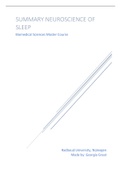SUMMARY NEUROSCIENCE OF
SLEEP
Biomedical Sciences Master Course
Radboud University, Nijmegen
Made by: Georgia Graat
,Sleep and dreaming
Humans spend a third of their lives asleep, in a state of disconnection from the surrounding world
and physical inactivity. Although it seems counterproductive for survival, sleep is an essential
integrated part of life. It has become increasingly clear that sleep plays an essential role for
mental and physical health: many physiological, immunological, metabolic, hormonal and
cognitive brain functions are processed during sleep and essentially contribute to the brain’s and
body’s function during wakefulness. Some differences between animals in sleep are the sleep
length, the day/night cycle, and the employed brain regions. There are 4 criteria that define sleep:
1) Different posture
2) Reduced activity
3) Arousal threshold high (do not react to small stimuli)
4) Homeostasis returns to normal
Sleep regulation knows a two-process model. Process C is the
circadian rhythm that drives sleep through day and night. Process S
is the sleep process that is dependent on behavior. The more you
are awake, the more you feel the need to sleep. This follows the
circadian rhythm normally, but differs depending on the sleep
schedule and taking naps or having sleep deprivation. However, the
circadian rhythm during the day works against the sleep deprivation,
making you feel less sleepy.
Chronobiology or chronotype is your
biological clock that knows when you should get tired and when you should
feel awake. There is an internal drive of sleep and awake that is run by light.
Biological clocks are being resynchronized every day, because they get cues
from social behavior, eating, and mostly sunlight. Besides, there is an annual
cycle due to the exposure to more or less light, that actually changes how long
people sleep during periods of the year and at what times. However, there is a
phenomenon called social jetlag where people change their sleeping schedules
hugely because of working-day hours, compared to when they normally go to
sleep on off days. This is highest in adolescents and young adults, where they
tend to sleep very late and are not optimally awake in the mornings.
, Microsleep is a phenomenon that can only be seen on an EEG. Part of the brain drifts off and falls
asleep sort of and for a very short time. We see less oscillations appear, meaning a general slowing of
brain activity. This can be dangerous if happening in certain situations like driving. It gives you the
feeling of drowsiness. This can happen in situations where you are recovering from sleep deprivation.
This recovery always takes a while. A long time of sleep deprivation can kill you due to many different
organ failures.
Waking up several times during the night is actually normal. Completely sleeping through the night
means you are sleep deprived. REM sleep however is never interrupted, one is in a state of paralysis
for a while. Stage 1, 2, and 3 are all 20 minutes each and alternate each other. REM sleep tends to
last longer.
Dreaming can be a reality stimulation with a good biological function. During dreaming, we can
encounter certain situations that are too dangerous in real life, but that help us in learning new skills
and coping with events. This could be for threat survival and training ourselves for threat coping
behavior. We train physical and mental skills useful in evolution, without actively remembering them,
so we can use them when necessary. During REM sleep, people tend to be able to recall much more
dream content and have movements which can be interpreted as dreams, while dreams actually
occur in every sleep stage.
The activation synthesis hypothesis shows the origin of dreams. The motor atonia/output is blocked,
and the sensory input is blocked. All the information must thus come from an internal source. The





